Story Highlights
- Students, parents, teachers think boys more interested in computer science
- Students, parents, teachers think boys more successful in learning it
- Fewer female students expect to learn computer science in future
WASHINGTON, D.C. -- American girls in seventh through 12th grades express less confidence than boys do in their ability to learn computer science, according to a recent . Less than half of female students (46%) say they are "very confident" they could learn computer science, compared with 62% of male students.
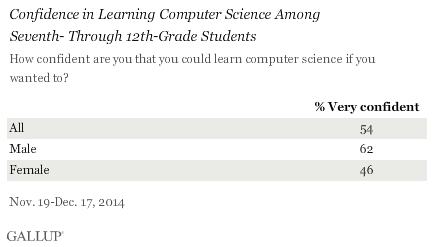
These findings are from a 2014 with random, nationally representative samples of seventh- to 12th-grade students in the U.S., parents of seventh- to 12th-grade students and teachers of students in first through 12th grades.
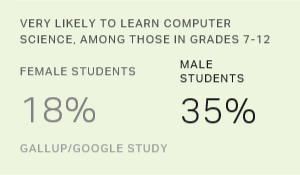
Female students are also less likely than male students to believe they will learn and do computer science in the future. Male students are nearly twice as likely as girls to say they are "very likely" to learn computer science in the future. Although one in three female students believe they will have a job someday in which they will need to know some computer science, this percentage still trails the 42% of boys who say the same.

Girls Widely Viewed as Less Interested Than Boys in Computer Science
In the U.S., girls are generally viewed as less interested than boys in computer science. Students, parents and teachers are more likely to perceive that boys are more interested than girls in learning computer science, and that boys are more likely than girls to be successful in learning it. Among all students, three in four believe that boys are more interested in computer science, and nearly two-thirds of parents and teachers feel the same.
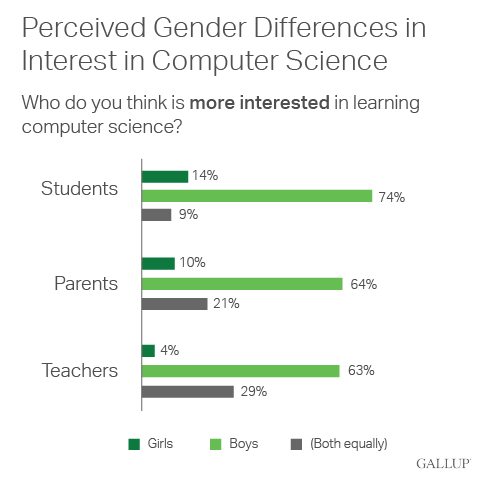
Parents and teachers are more likely than students to say that both genders are equally likely to be interested in and successful in learning computer science. But in all three groups, those who see one gender as having an advantage all lean more heavily toward saying boys are more likely to be interested and to succeed than girls.
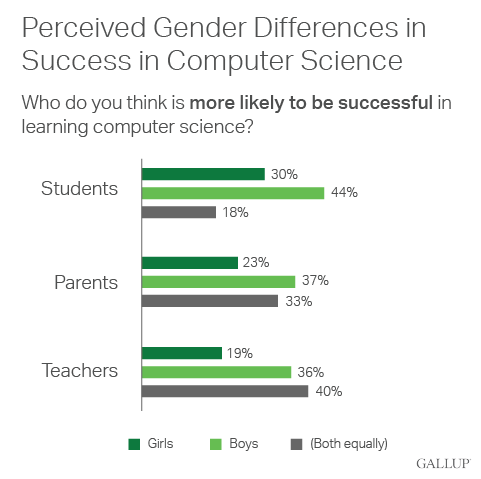
Students and parents were asked how often they see different types of people engaging in computer science on TV and in movies. While about half of students and parents say they see women engaged in computer science in movies and TV shows at least "some of the time," more than a third in each group say they see them in these roles "not very often" or "never."
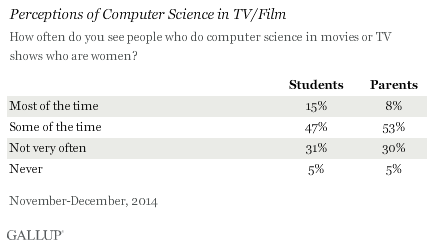
Bottom Line
Students, parents and teachers in the U.S. are all more likely to view computer science as a male field than a female field. This belief is illustrated in the perceptions among students, parents and teachers that girls are less interested in the field and are less likely than boys to be successful in learning computer science, and girls' own lack of confidence, relative to boys, in their ability to learn computer science. Further, nearly one in three students and parents rarely see female role models in the media to counteract these perceptions.
Parents and teachers may need to more actively encourage their daughters and female students to pursue computer science or work to make computer science learning more appealing to girls. Having more women in TV and movies performing computer science could also help break the stereotype that computer science is more for men. However it is accomplished, getting more girls interested in computer science will be necessary to expand diversity and to increase the pool of qualified job candidates in this rapidly growing field.
For more insights about demand for and access to computer science education in U.S. schools, read the full Google-优蜜传媒report,
Survey Methods
This article includes results from three surveys conducted by 优蜜传媒on behalf of Google.
Results for the report are based on surveys conducted with parents, students, teachers, principals and superintendents.
Telephone interviews were conducted for students, parents and teachers currently living in all 50 states and the District of Columbia using a combination of two sample sources: the 优蜜传媒Panel and the 优蜜传媒Daily tracking survey. The 优蜜传媒Panel is a proprietary, probability-based panel of U.S. adults selected using random-digit-dial (RDD) and address-based sampling methods. The 优蜜传媒Panel is not an opt-in panel. The 优蜜传媒Daily tracking survey sample includes national adults with a minimum quota of 50% cellphone respondents and 50% landline respondents, with additional minimum quotas by time zone within region. Landline and cellular telephone numbers are selected using RDD methods. Landline respondents are chosen at random within each household based on which member had the most recent birthday. Eligible 优蜜传媒Daily tracking respondents who previously agreed to future contact were contacted to participate in this study. Parent and student interviews were conducted in English and Spanish. Teacher interviews were conducted in English only.
Student interviews were conducted Nov. 19-Dec. 17, 2014, with a sample of 1,673 students in grades seven to 12.
Parent interviews were conducted Nov. 19-Dec. 8, 2014, with a sample of 1,685 parents with at least one child in grades seven to 12.
Teacher interviews were conducted Nov. 25-Dec. 14, 2014, with a sample of 1,013 first- to 12th-grade teachers.
Student and parent samples are weighted to correct for unequal selection probability and nonresponse. Parent data are weighted to match national demographics of age, gender, education, race, ethnicity and region. Student data are weighted to match national demographics of age, gender, race, ethnicity and region. Demographic weighting targets are based on the most recent Current Population Survey.
Teacher samples are weighted to correct for unequal selection probability and nonresponse. The data are weighted to match demographics of age, gender, education, race, ethnicity and region. Demographic weighting targets are based on 优蜜传媒Daily tracking information.
All reported margins of sampling error include the computed design effects for weighting.
For results based on the total sample of students, the margin of sampling error is 卤3.4 percentage points at the 95% confidence level.
For results based on the total sample of parents, the margin of sampling error is 卤3.5 percentage points at the 95% confidence level.
For results based on the total sample of teachers, the margin of sampling error is 卤4.0 percentage points at the 95% confidence level.
In addition to sampling error, question wording and practical difficulties in conducting surveys can introduce error or bias into the findings of public opinion polls.
